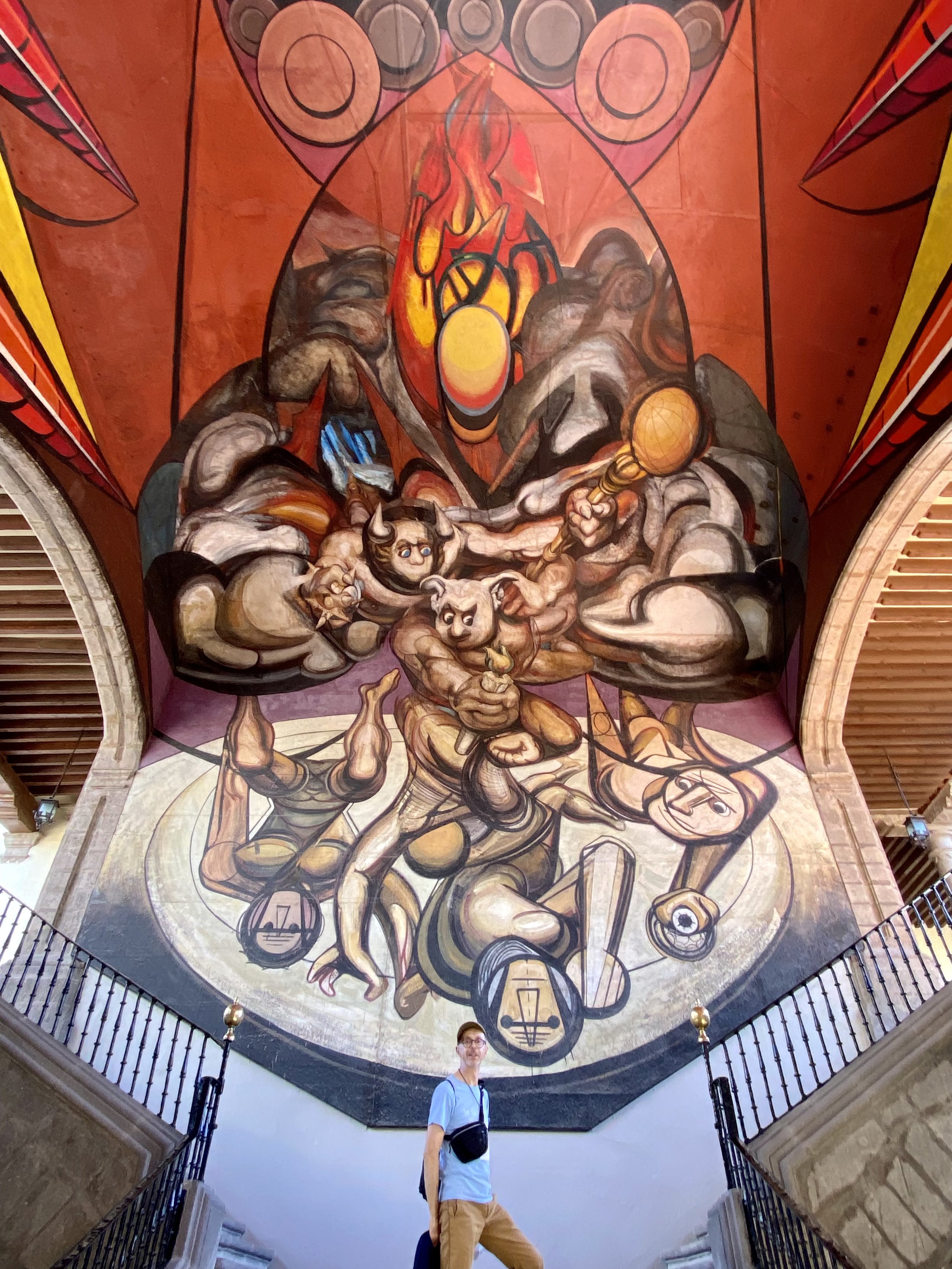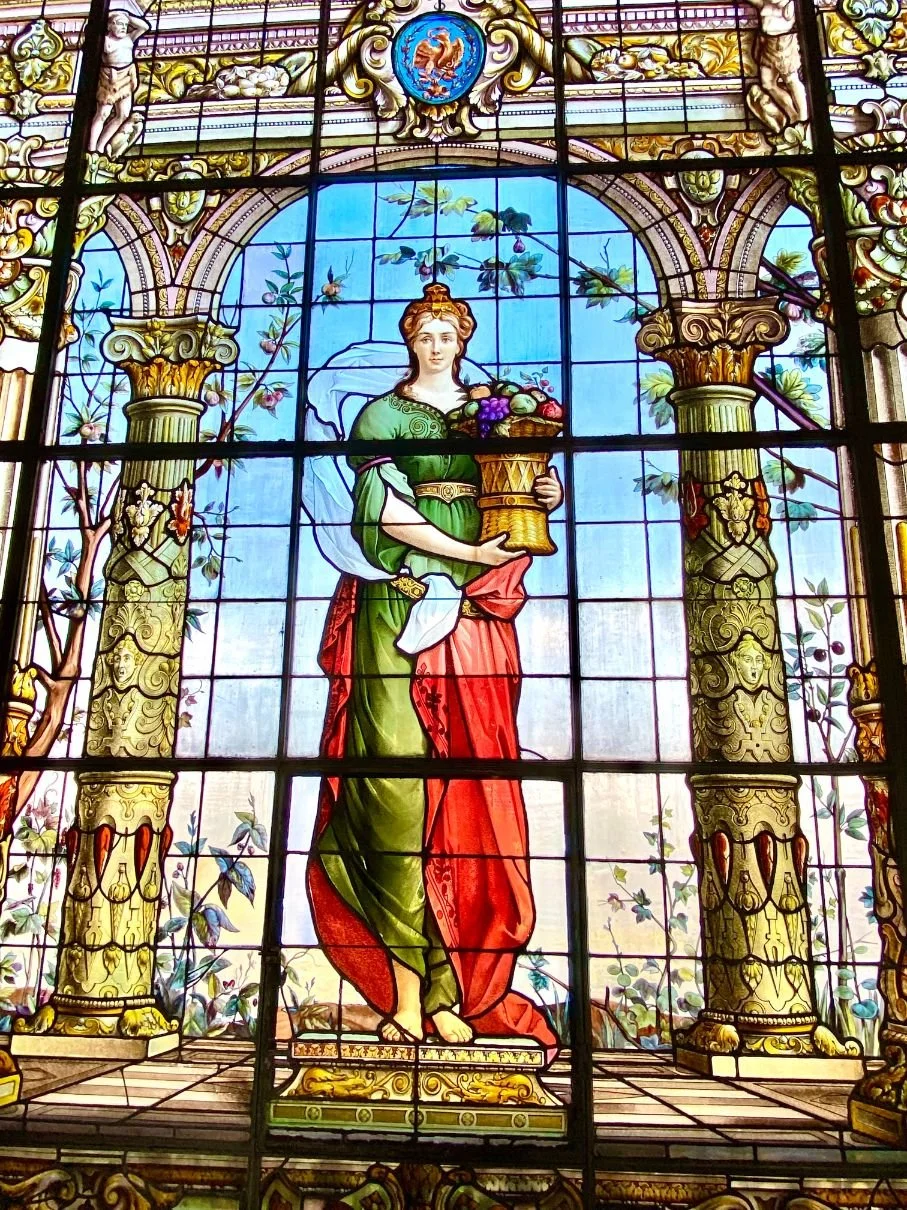While we have breakfast on the roof terrace of the Majestic Hotel we can gaze out over the Palacio Nacional which houses a world famous mural by the painter Diego Rivera. I was lucky enough to see it on previous trips but now that the building is closed to the public we start our day instead with a visit to the Secretaria de Educación Publica in nearby Plaza de Santo Domingo, which houses a series of incredible murals and frescos by Rivera and other artists, depicting the history, daily life and struggle for independence of the Mexican people. They’re stunning, as is the building they adorn over three floors.
But our main location for the day is Chapultepec Park, a green oasis in the centre of the city which has both a museum and a castle I’m keen to revisit and show Coman. So we hop in an Uber and drive out of the historical centre and through the grand boulevards of the Roma district, past the skyscrapers and swanky international hotels I’ve stayed in with bands before, and around the iconic Angel of Independence statue.
We’re dropped off at the Nacional Museo de Anthropologie, which has stayed in my memory for 15 years as one of the world’s greatest displays of human history… and it’s even more incredible this time round. It’s also more enormous than I remember with an overwhelming amount of exhibits detailing life in the Americas from prehistoric times until the post colonial era. But of course, its greatest treasures come from the rich period of indigenous culture spanning the two thousand years before the Spanish conquest in the 16th century.
The displays are phenomenally done and we walk around trying to take it all in. There’s exhibits of Toltec, Olmec, Zapotec, Mixtec and various other tribes and cultures laid out in brilliantly designed rooms, with reconstructions of temples and buildings both inside the vast spaces and in the gardens around the museum.
A whole section is dedicated to Teotihuacan, a vast religious complex about an hour outside Mexico City that influenced many of the indigenous cultures of Mesoamerica. Unfortunately we don’t have time to visit Teotihuacan while we’re here, but I’ve been lucky enough to climb both the huge Pyramids of the Sun and the Moon there in the past, an act which we learn has since been banned.
The enormous display dedicated to the Aztecs here gives them their modern name, the Mexica. Legend says that the tribe came south, from the mythical land of Aztlan searching for the sign their shaman had predicted would announce the site of their new land. It would be where they found an island with a cactus on which would be perched an eagle eating a snake. Eventually on a vast lake in the centre of the country, their warriors witnessed it happening.
So the Aztlan tribe settled and built their city, Tenochtitlan, named after Tenoch their leader, and they became known and feared by other races all around for their practice of human sacrifice. The Spanish called them by the old name of Aztec, but they are called Mexica by modern Mexicans and gave their name to both the nation state and the largest city in the Americas.
The final rooms are dedicated to the Maya, showcasing sites like Chichen Itza and Coba that we have both visited before in the Yucatán, and many more including Palenque and Tikal which we will visit on our adventure to come. And it’s the reconstruction of the tomb of Lord Pakal, which was discovered at Palenque, which is the most eye catching display along with his dramatic jade death mask.
By the time we’ve finished we’re starving so stop for lunch at the museum’s beautiful restaurant before venturing further into Chapultepec Park itself. Street vendors are everywhere and outside the museum the whistles and beating drums of men in traditional dress, gracefully circling headfirst through the air from a ceremonial pole, echo through the park.
We walk past the lake, around which people row little boats and children race each other in pedallos, before ascending the hill to the Castillo de Chapultepec which houses the National Musem. It’s a beautiful building and was home to Maximilian, Archduke of Austria, and his wife Charlotte, daughter of Belgian King Leopold I, who were sent by the French to establish European royal dominance over Mexico in 1868, to counter the revolutionary rule of Benito Juarez and to stop the United States’ advances into Mexico.
The Castillo is a prime example of a European palace, sat atop a hill gazing across the city. Its rooms depict the short-lived but luxurious rule of Maximilian before he was dethroned just two years later and executed, and continues through the history of Mexico until the 1940s and modern democratic rule.
We race around viewing as much as we can and just about manage to cram it all in before the guards start whistling to signify opening time is over and all the tourists must leave. We wend our way back down the hill and leave the park to walk through the backstreets of La Condesa district. Obviously a wealthy and trendy area, it has an LA style vibe and we rest our weary feet at a cool cafe, to have an oat milk latte and vegan brownie.
We haven’t got time to return to our hotel before our evening street food tour so we continue our wanderings until we get to Parque Mexico, a pretty central park surrounded by bars and restaurants like Cafe Ruga where Coman orders a margarita and I knock back a Corona. It’s the perfect spot to call an Uber to take us to the district of Navarte, in the south of the city.
It’s a locals-only kind of area and we are dropped on a busy corner with just a street number and Google Maps to help us, but we soon find Tonali, our guide from Eat Mexico, sat at a table at a roadside taco bar called La Costilla. She’s been taking tourists around Mexico’s funkiest areas for the past few years and helping them delve into the kind of dishes and eateries that are well off the beaten track, and once our fellow tourists - a father and son from Houston, both called Patrick - join us, she takes us on a walking tour of Navarte in search of some very typical Mexican cuisine.
At La Costillo we start with a drink of hibiscus agua frescas and then Tonali orders charcoal grilled tostadas volcán with poblano peppers. We have very spicy salsa rojo with chili de árbol and salsa verde with tomatillo and guacamole, but the real highlight is the ajo tostada which is so pungent with sweet and buttery garlic it almost blows my head off.
As soon as we’re finished we walk a couple of blocks to Los Cuates cantina for a quesadilla with epacote, a wild herb halfway between coriander and rocket, washed down with dark Victoria beer. Tonali fills us in on the macho history of Mexican cantinas and how they’ve evolved in recent years, before we’re on the move again to a packed street stall called El Vilcito, made famous in the Netflix series The Taco Chronicles.
By day it’s a garage where mechanics fix cars but at 6pm the grills are fired up, huge pork rotisseries are set aflame and chefs carve up slabs of meat that fly into tacos with a slice of pineapple from atop the burning meat. The two Patricks tuck in with gusto while Coman and I have nopale tacos instead, made from grilled cactus with the ubiquitous cheese. It’s carnivore heaven at the next place too - Taco Tony - just a few metres away, where we watch the Texan father and son devour more slaughtered pig.
But at Don Frank, a growing Mexican street food chain we all are served alhambre, a spicy vegetarian taco full of mushroom, courgette flowers and avocado, rounding off our gastronomic gluttony with a tasty flourish. However, the tour has one more stop to go. Tonali leads us down another few streets until we arrive at a restaurant called Piloncillo y Cascabel, owned by the charmingly dangerous Wenceslao.
A mezcal connoisseur he eulogises over the smoky spirit, determined to make us evangelical converts too. Four bottles are produced from different parts of the country - Durango, Guerrero, Oaxaca and Pechuga - and he talks us through each one and their different characteristics, like a wine sommelier at their most eloquent. Considering it’s now almost midnight, we’ve had a long day and are still pretty jet-lagged, the fact they’re all between 48% and 53% alcohol means we’re struggling to keep up with his descriptions as he leads us in a tasting session up and down the series of glasses before us, encouraging us to take sip after sip as oxygenation changes the nuances of flavour. “You don’t drink mezcal,” he tells us. “You kiss it!”
God bless Wenceslao and Tonali but the time has come for us to take our leave, despite the fact they’d happily keep plying us with food and drink well into the early hours. We have an 8am departure to Puebla in the morning and so, wrapped in the warm glow of agave liquor, we get an Uber back to the centre of the city and a final night’s sleep at the Majestic Hotel.
Mexico City, we’ll be back for more in a few week’s time!












































